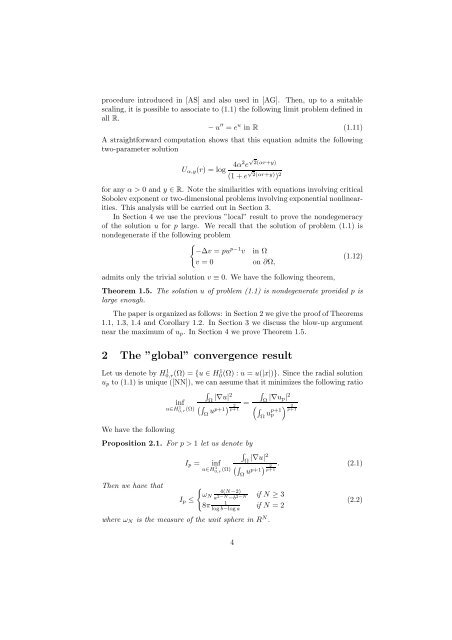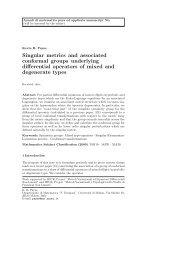Asymptotic behaviour of the Kazdan-Warner solution in the annulus ∗
Asymptotic behaviour of the Kazdan-Warner solution in the annulus ∗
Asymptotic behaviour of the Kazdan-Warner solution in the annulus ∗
You also want an ePaper? Increase the reach of your titles
YUMPU automatically turns print PDFs into web optimized ePapers that Google loves.
procedure <strong>in</strong>troduced <strong>in</strong> [AS] and also used <strong>in</strong> [AG]. Then, up to a suitable<br />
scal<strong>in</strong>g, it is possible to associate to (1.1) <strong>the</strong> follow<strong>in</strong>g limit problem def<strong>in</strong>ed <strong>in</strong><br />
all R.<br />
− u ′′ = e u <strong>in</strong> R (1.11)<br />
A straightforward computation shows that this equation admits <strong>the</strong> follow<strong>in</strong>g<br />
two-parameter <strong>solution</strong><br />
Uα,y(r) = log 4α2 e √ 2(αr+y)<br />
(1 + e √ 2(αr+y) ) 2<br />
for any α > 0 and y ∈ R. Note <strong>the</strong> similarities with equations <strong>in</strong>volv<strong>in</strong>g critical<br />
Sobolev exponent or two-dimensional problems <strong>in</strong>volv<strong>in</strong>g exponential nonl<strong>in</strong>earities.<br />
This analysis will be carried out <strong>in</strong> Section 3.<br />
In Section 4 we use <strong>the</strong> previous ”local” result to prove <strong>the</strong> nondegeneracy<br />
<strong>of</strong> <strong>the</strong> <strong>solution</strong> u for p large. We recall that <strong>the</strong> <strong>solution</strong> <strong>of</strong> problem (1.1) is<br />
nondegenerate if <strong>the</strong> follow<strong>in</strong>g problem<br />
<br />
−∆v = pup−1v <strong>in</strong> Ω<br />
(1.12)<br />
v = 0 on ∂Ω,<br />
admits only <strong>the</strong> trivial <strong>solution</strong> v ≡ 0. We have <strong>the</strong> follow<strong>in</strong>g <strong>the</strong>orem,<br />
Theorem 1.5. The <strong>solution</strong> u <strong>of</strong> problem (1.1) is nondegenerate provided p is<br />
large enough.<br />
The paper is organized as follows: <strong>in</strong> Section 2 we give <strong>the</strong> pro<strong>of</strong> <strong>of</strong> Theorems<br />
1.1, 1.3, 1.4 and Corollary 1.2. In Section 3 we discuss <strong>the</strong> blow-up argument<br />
near <strong>the</strong> maximum <strong>of</strong> up. In Section 4 we prove Theorem 1.5.<br />
2 The ”global” convergence result<br />
Let us denote by H1 0,r(Ω) = {u ∈ H1 0(Ω) : u = u(|x|)}. S<strong>in</strong>ce <strong>the</strong> radial <strong>solution</strong><br />
up to (1.1) is unique ([NN]), we can assume that it m<strong>in</strong>imizes <strong>the</strong> follow<strong>in</strong>g ratio<br />
<br />
<br />
We have <strong>the</strong> follow<strong>in</strong>g<br />
<strong>in</strong>f<br />
u∈H 1 0,r (Ω)<br />
<br />
Ω<br />
Ω |∇u|2<br />
up+1 2<br />
p+1<br />
= Proposition 2.1. For p > 1 let us denote by<br />
<br />
Ω |∇u|2<br />
<br />
Then we have that<br />
Ip = <strong>in</strong>f<br />
u∈H 1 0,r (Ω)<br />
Ip ≤<br />
Ω<br />
Ω<br />
|∇up| 2<br />
Ω up+1 p<br />
up+1 2<br />
p+1<br />
<br />
ωN 4(N−2)<br />
a2−N −b2−N if N ≥ 3<br />
1 8π log b−log a if N = 2<br />
where ωN is <strong>the</strong> measure <strong>of</strong> <strong>the</strong> unit sphere <strong>in</strong> R N .<br />
4<br />
2<br />
p+1<br />
. (2.1)<br />
(2.2)








